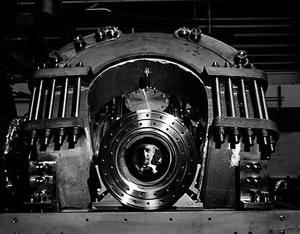Ansel Adams' greatest passions: wilderness preservation and fusion energy
No one better than Californian photographer Ansel Adams (1902-1984) has captured the majesty and grandeur of the American landscape. Using a meticulous darkroom technique known as "zone printing", his vision magnified the humble and the grandiose alike, a full moon rising over a Mexican village or a clearing winter storm over Yosemite National Park.
Adam's relation to nature was both aesthetic and mystical. Throughout his life he worked and lobbied to preserve the wilderness and the great vistas of the American West. His book on The John Muir Trail was instrumental in the creation of Kings Canyon National Park in1940.
One of Adam's lesser known passions was fusion energy. In Autumn 1966, he had been commissioned by Livermore National Laboratories to photograph various machines and installations, among them "ALICE" (Adiabatic Low-energy Injection and Confinement Experiment), a "mirror machine" which was expected to demonstrate "scientific feasibility" by the end of the decade...
The Livermore commission was Adam's first exposure to fusion energy. Later in life, he became one of its most ardent advocates. In "Ansel Adams, an autobiography", published posthumously in 1984, the photographer tells of his June 1983 meeting with fellow Californian Ronald Reagan, whose environmental policies he had been criticizing sharply for years. "I suggested he take $ 10 billion from his defense program and apply it to a crash program for magnetic fusion development. Reagan raised an eyebrow at my temerity, but I believe it is obvious that, once fusion power is achieved, the energy shortage will be past."
Two and a half years later, on November 19, 1985, President Reagan was meeting Secretary General Gorbachev in Geneva, laying the political foundations of what was to become the ITER project. Maybe, on that occasion, the US president remembered the words of the bearded 82-year-old photographer-conservationist who had caused his eyebrow to rise. Adams had died the year before, convinced, as he expressed in his last interview to a San Francisco magazine, that fusion "wasn't that far down the road", that is, "only as far as our leaders want to make it."



